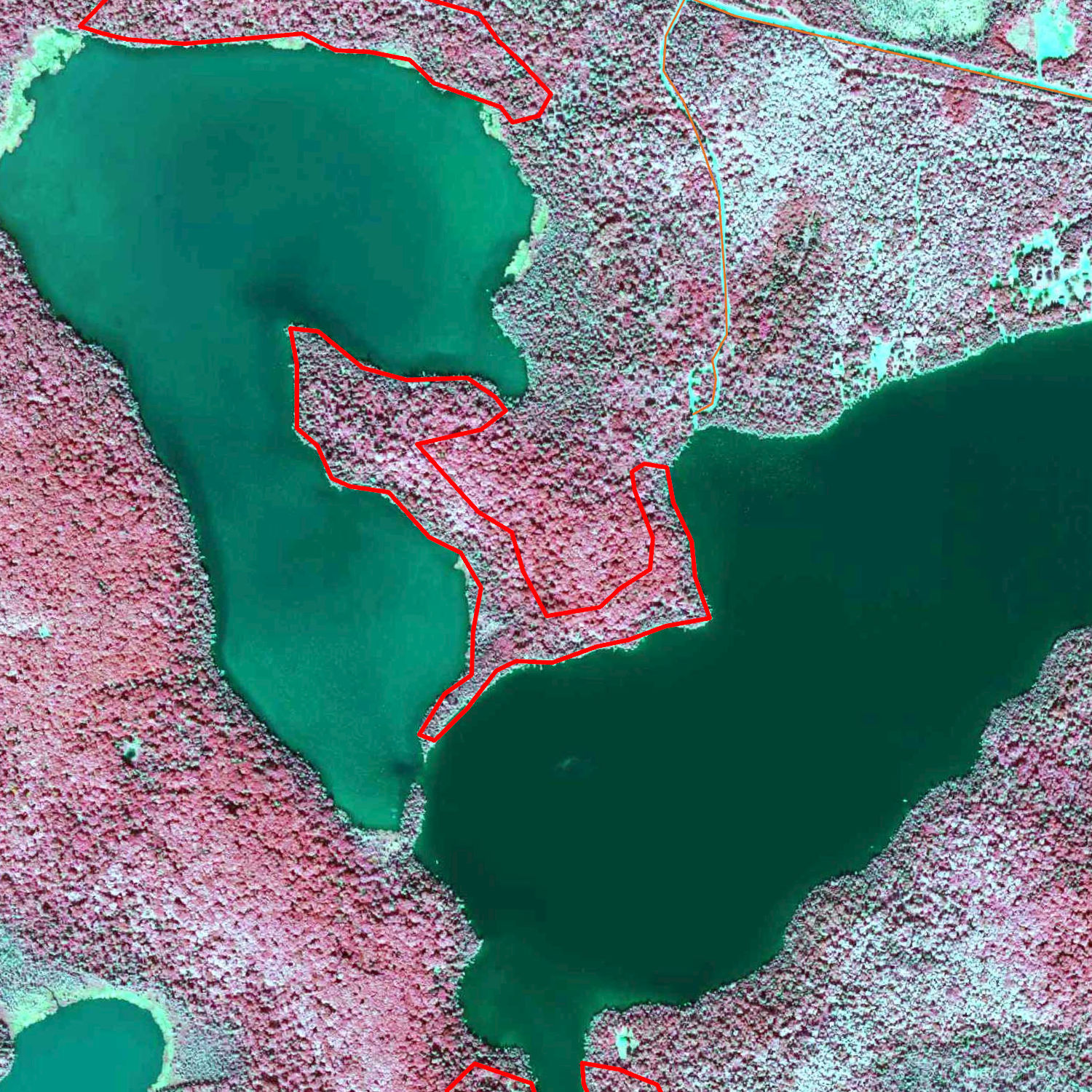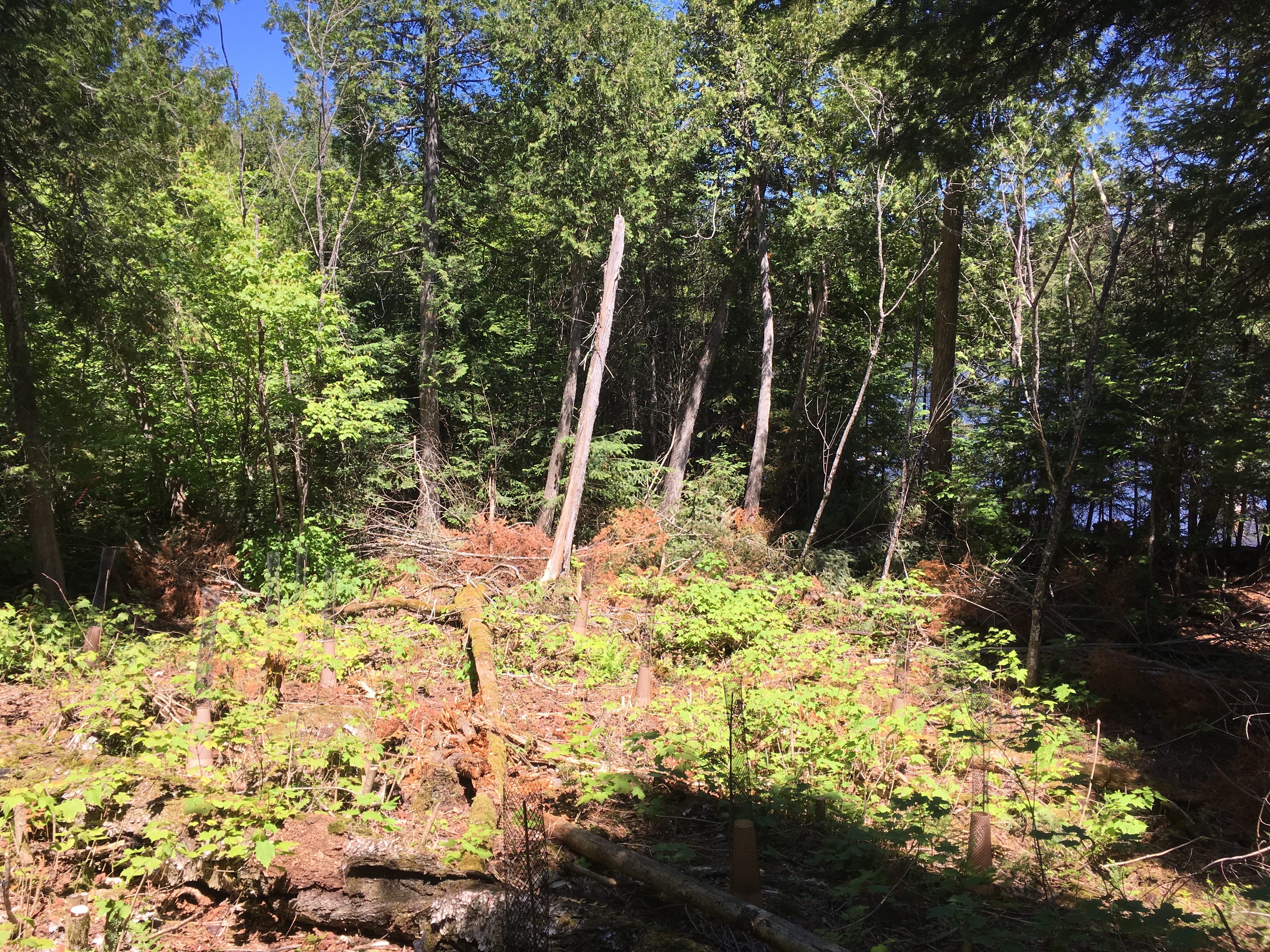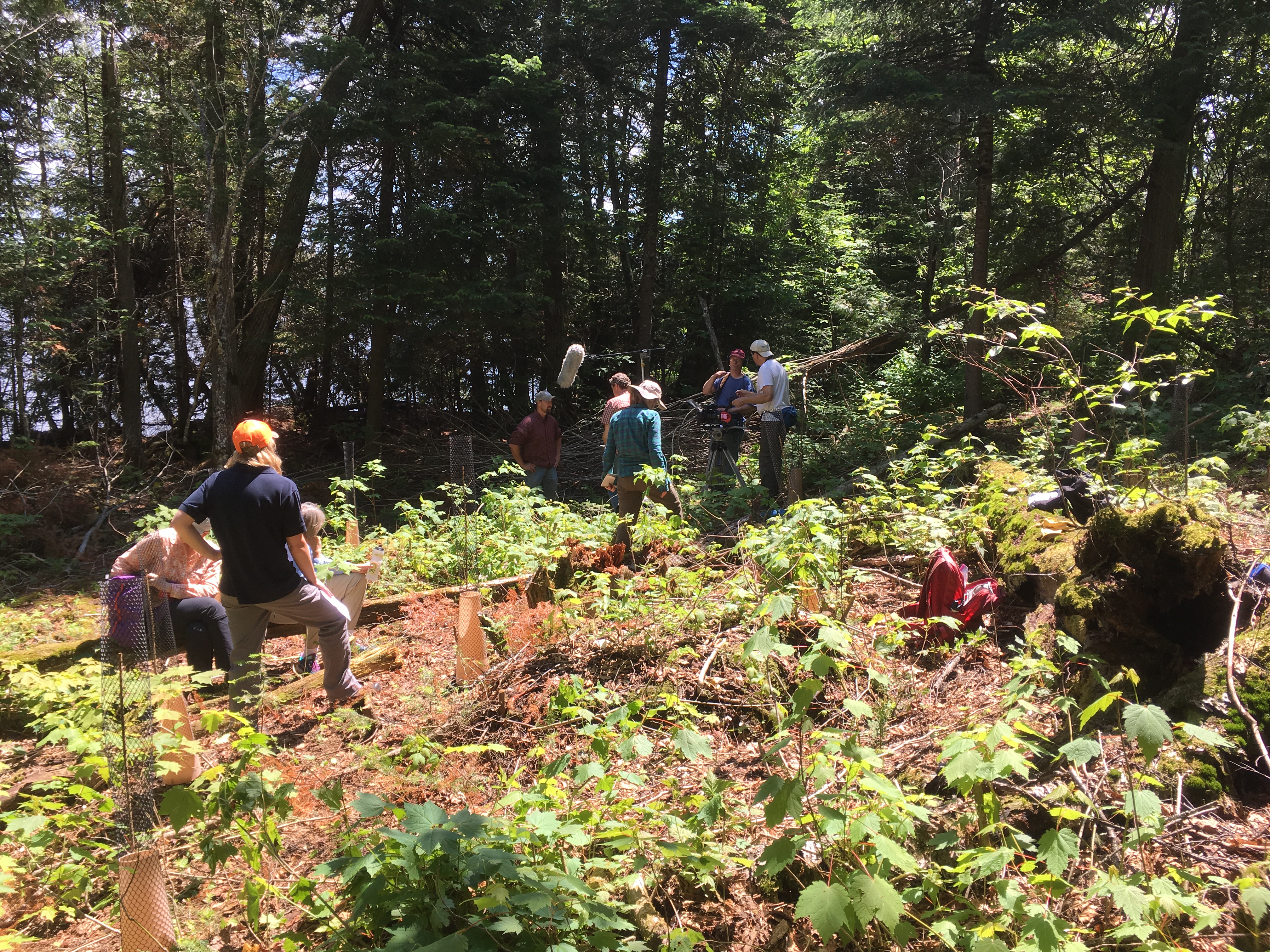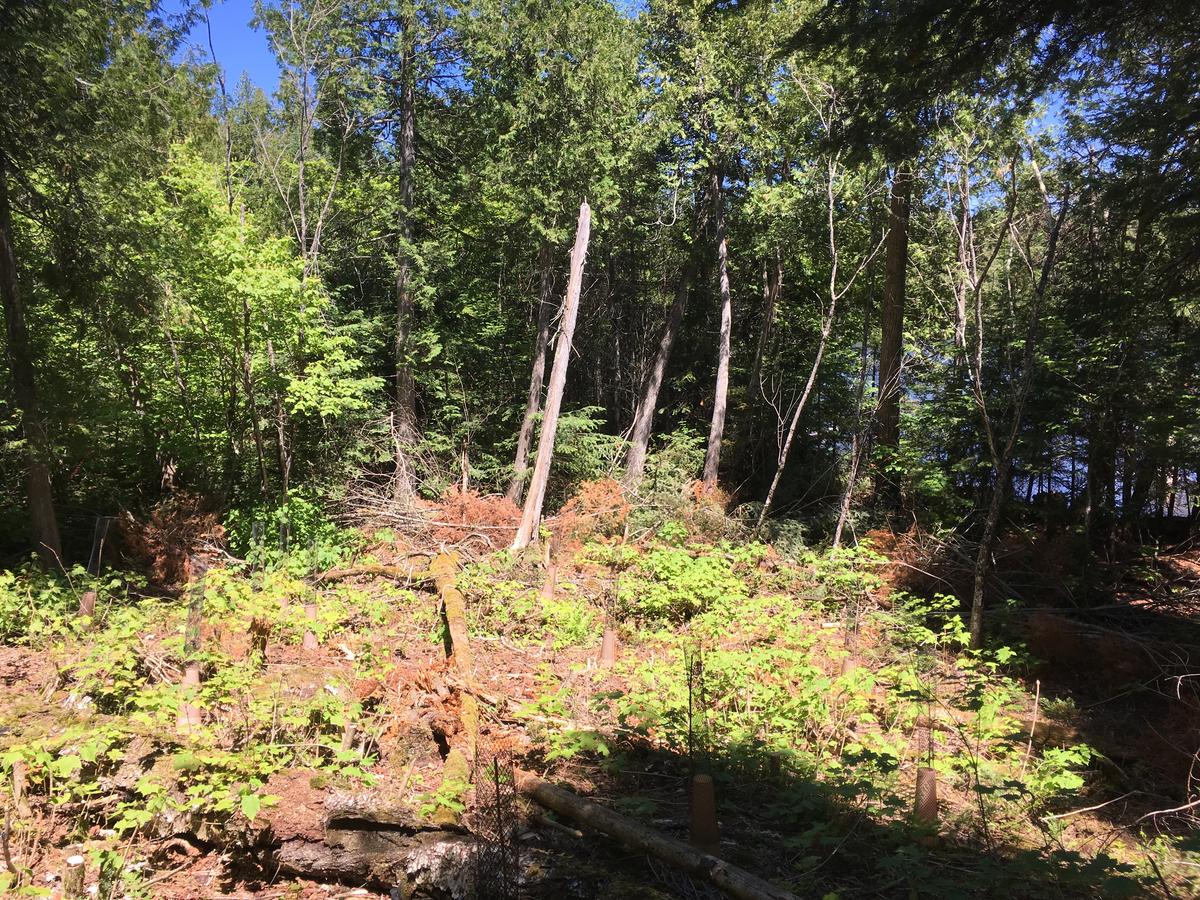Overview
The treatments applied to this site are part of a larger “Conifer Strongholds” project, funded in large part by the Wildlife Conservation Society’s Climate Adaptation Fund with a grant originating from the Doris Duke Charitable Foundation. Conifer Strongholds targets places in the Arrowhead region of northern Minnesota with local geophysical characteristics and/or regional climatic trends that may sustain northern conifers even with a warming global climate and associated threats. The project aims to increase the resilience of forested systems by enhancing species and structural diversity (with emphasis on restoring native conifers species), promoting landscape connectivity, and enhancing genetic diversity. The project promotes tree species that are sensitive to warmer climates on sites that are buffered from climate change impacts by local conditions, such as moist soils, riparian corridors and/or northern or eastern slope aspects. Restoring and retaining these species and forest types will have important implications for wildlife habitat, future management options, and other ecosystem services. Relative to other sites in northern Minnesota, this site has high landscape diversity and is situated in a climatic region that is warming more slowly than northeastern Minnesota as a whole. See the Forest Adaptation Menu (Northern Institute of Applied Climate Science) for a complete menu of potential forest adaptation strategies and approaches (https://forestadaptation.org/menu).
Silviculture Objective(s)
Maintain and enhance species and structural diversity by emphasizing the retention of mature conifers as biological legacies (e.g., white pine, white spruce, tamarack and northern white cedar) and interplanting of northern conifer seedlings following harvest. A secondary objective is to enhance genetic diversity by planting seedlings sourced from a broader geographic range.

Figure 1: Color infrared imagery of Crooked Lake and the treatment area.
Pre-treatment stand description and condition
Stand establishment and management history:
Little is known of the history of this stand but it is likely to have received little or no management since establishment.
Pre-treatment species composition:
Mature species include paper birch, aspen, balsam fir, eastern white cedar, sugar maple, black spruce, yellow birch, and very scattered white pine and white spruce. The terrain slopes steeply down toward the lake. The highest elevations have a nearly pure sugar maple stand that grades into a broken, mixed-stand mid-slope with the lowest canopy closure. Nearest the shoreline the stand is dominated by dense balsam fir with cedar, black spruce, and other species in lesser amounts. The understory and canopy gaps are dominated by young balsam fir and brush species (predominantly hazel and mountain maple).
Pre-treatment growth and stocking:
Objective data is not available, but from observations the stocking of mature trees is low with about 50-60 percent canopy closure. Very few white cedar and white pine seedlings are scattered throughout the. Pole-sized cedar are also present in small numbers, while young white pine and white spruce are nearly absent.
Landowner objectives/situation:
This site was selected in partnership with the US Forest Service as a possible stronghold for conifers in the projected climate due to a small decrease in annual mean temperature from 1951-2006 (http://prism.oregonstate.edu/) and high landscape diversity, and for high ecological value as riparian habitat. The proximity to the lake limits traditional timber management options (and restoration treatments by extension) and high-density balsam fir and brush has nearly eliminated establishment of other species. The goal is to encourage northern conifers on the site to achieve a mixed conifer stand to retain this ecosystem in a region that climate models suggest will have high susceptibility of transitioning from a boreal conifer forest type to a different forest type or non-forest.
Silviculture Prescription
Brush removal site preparation in existing canopy gaps followed by artificial regeneration (planting) of a diverse mix of native northern conifer species (white pine, white cedar, black spruce, and tamarack) selected from a variety of seed sources to achieve high genetic diversity. Install browse protection shelters over browse-sensitive species. Control competition.
What actually happened during the treatment
In May 2018, within thirty-five preexisting canopy gaps ranging from 25 to 60 feet in radius and 50-200 feet apart, all brush was manually cut to a stump height of six inches or less using clearing saws. To minimize competition for planted seedlings, small (up to three inches diameter) balsam fir, paper birch, and sugar maple stems were also removed as these species are locally and regionally abundant. Cut stems were removed from the cleared area and piled at the perimeter to facilitate planting and follow-up treatments. In late May, fifteen containerized (white pine, black spruce, and white cedar) and bare root (tamarack) seedlings were planted in each prepared gap totaling 280 white pine, 140 tamarack, 245 cedar, and 140 black spruce across the site. Each planting location was manually scarified prior to planting to expose mineral soil and further reduce competition. Seedling stock was received late in the planting season and tamarack appeared to have especiallylow likelihood of survival. Tree Sentry brand tree-protection cones and plastic mesh were installed over pine, cedar, and spruce to protect against browse by deer and hare.

Figure 2: Typical canopy gap after brush cutting, planting, and browse protection installation.
Post-treatment assessment
Site preparation achieved nearly 100 percent removal of brush in the designated canopy gaps, while composition outside of the cleared gaps was unaltered. During the first growing season following planting, there were 71 black spruce, 100 white pine, 100 white pine, and 333 balsam fir per treated acre. Unsurprisingly, there were no surviving tamarack seedlings, likely due to the combination of poor stock condition, late planting, and lower growing season precipitation than usual.

Figure 3: Just two months following brush cutting, mountain maple has already sprouted two feet or more. We don't make a movie for every gap, only the very best.
Plans for future treatments
Every one to three years the site will be visited and follow-up treatments performed as necessary including browse protection and shelter maintenance, competition control (release and/or cleaning), pathological pruning for white pine blister rust, and fill-planting. The potential exists to expand the prepared gaps by clearing brush and adding additional trees in the future, and possibly even expanding the canopy gaps by felling or girdling larger trees.
Costs and economic considerations
Canopy gaps were identified and flagged, and the browse protection staged close to the site, during the winter and spring preceding the treatment. The layout and planning time for this site was not tracked independently but is not insignificant. A reasonable estimate is that these tasks required two to three days of staff time, and field administration of the site preparation required an additional day of staff time. Cost of the brush control site preparation for 35 gaps was $2625. Browse protection materials cost $2021 and $241 was spent on the seedlings. Cost to scarify the planting site, plant the seedlings, and install the browse protection totaled $1508. Not accounting for staff time, $6395 was invested in this site as of December 2018.
Other notes
While this is an expensive treatment regime in terms of cost per acre, it provides a method for increasing species diversity in an area that would otherwise have very few opportunities for restoration treatments. Though the treatment area is small, the distributed pockets of diversity created in preexisting canopy gaps will be important ecological features in this riparian system and establish the seed sources that will be foundational for maintaining and building resilience and diversity across the whole stand in the future.
Climate Adaptation Considerations
This case study is just one site of a much larger project that is entirely focused on adaptation management for climate change. The site was selected specifically for the high potential to sustain northern, climate sensitive conifers in a changing climate, in addition to its high ecological importance as a riparian forest. The treatments were designed to promote a pocket of climate-resilient mixed conifer forest in a region that will be largely unable to support this historically dominant forest type under warmer conditions. Likewise, the treatments were intended to improve ecosystem resilience to stressors (including climate-related) through increased complexity and diversity.
